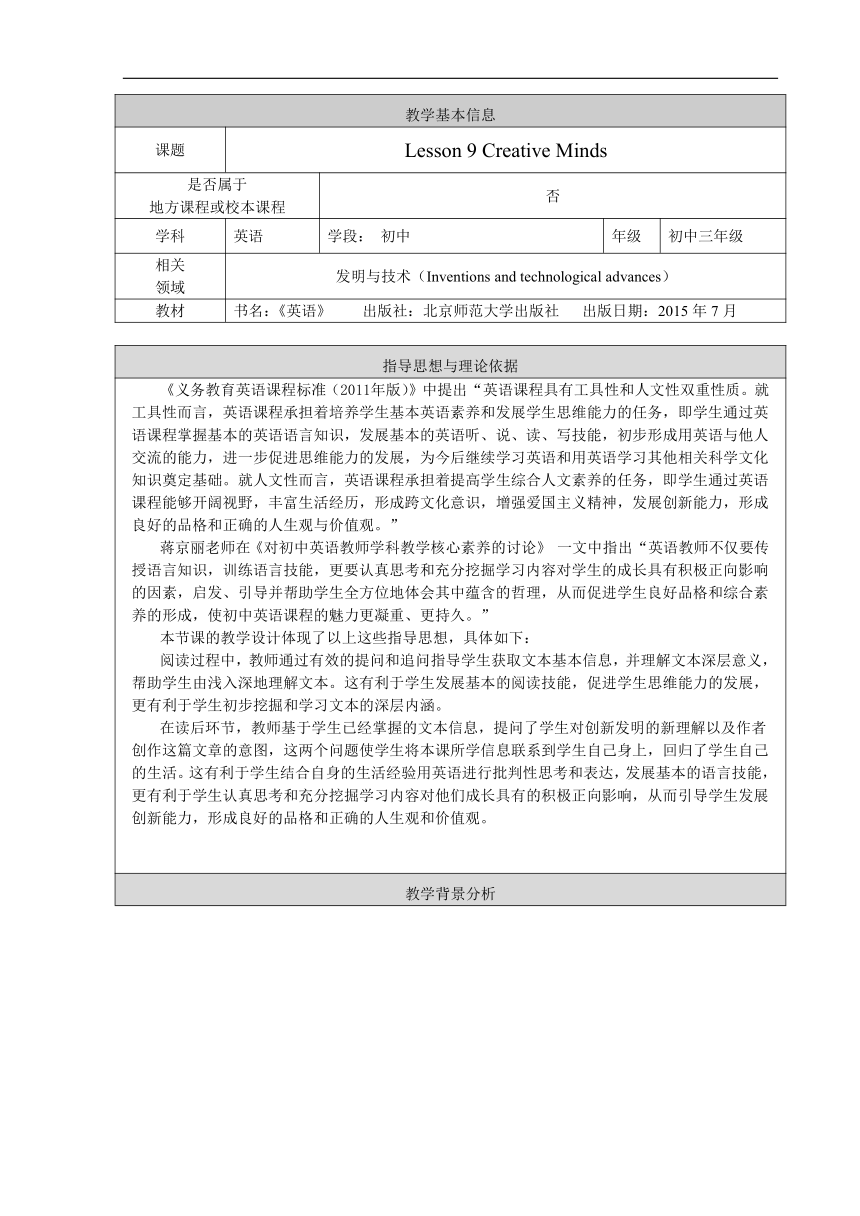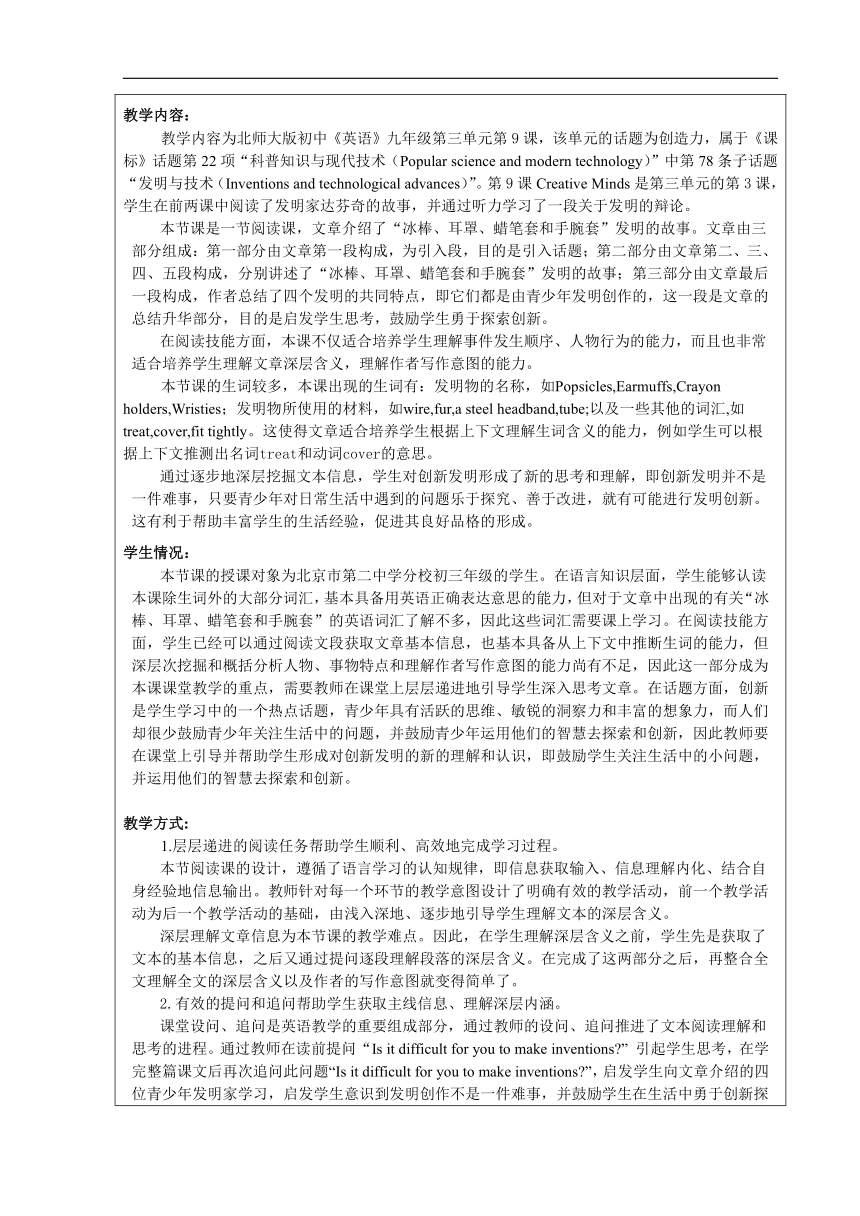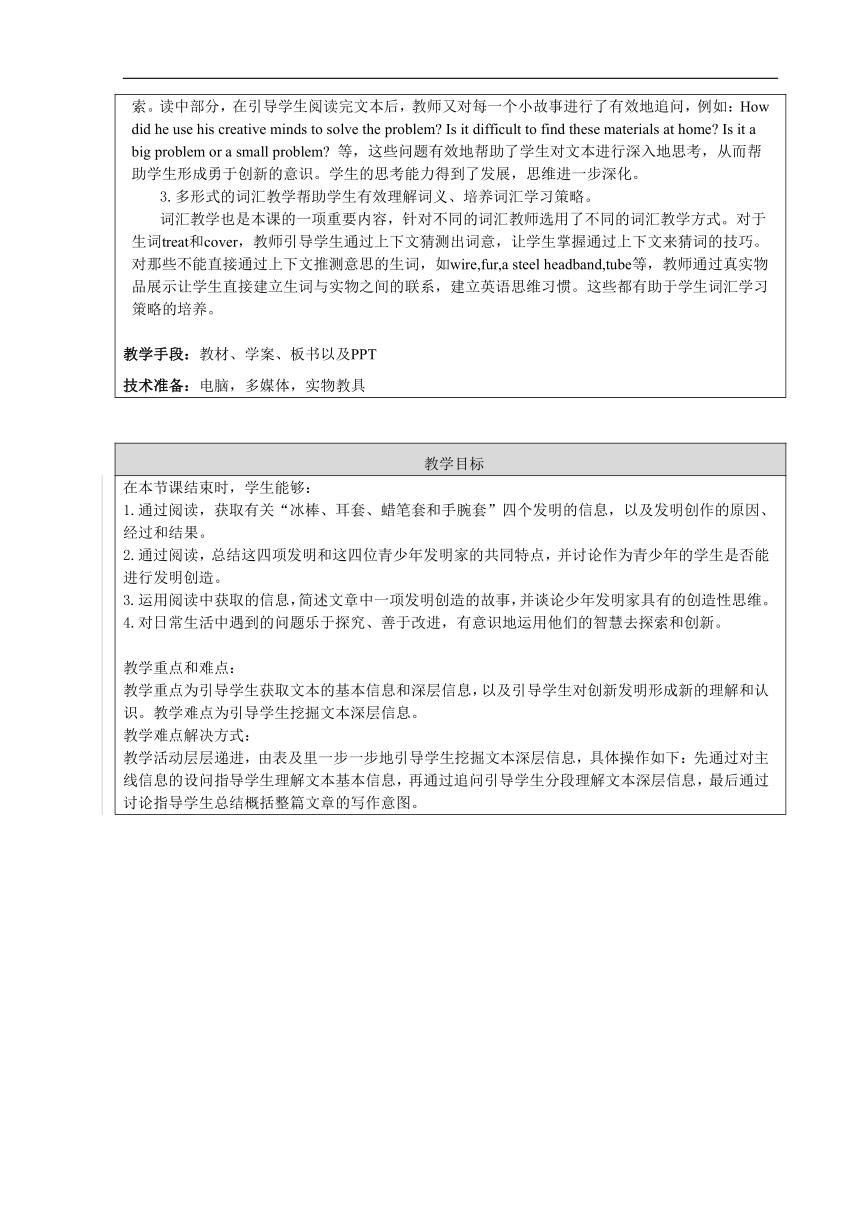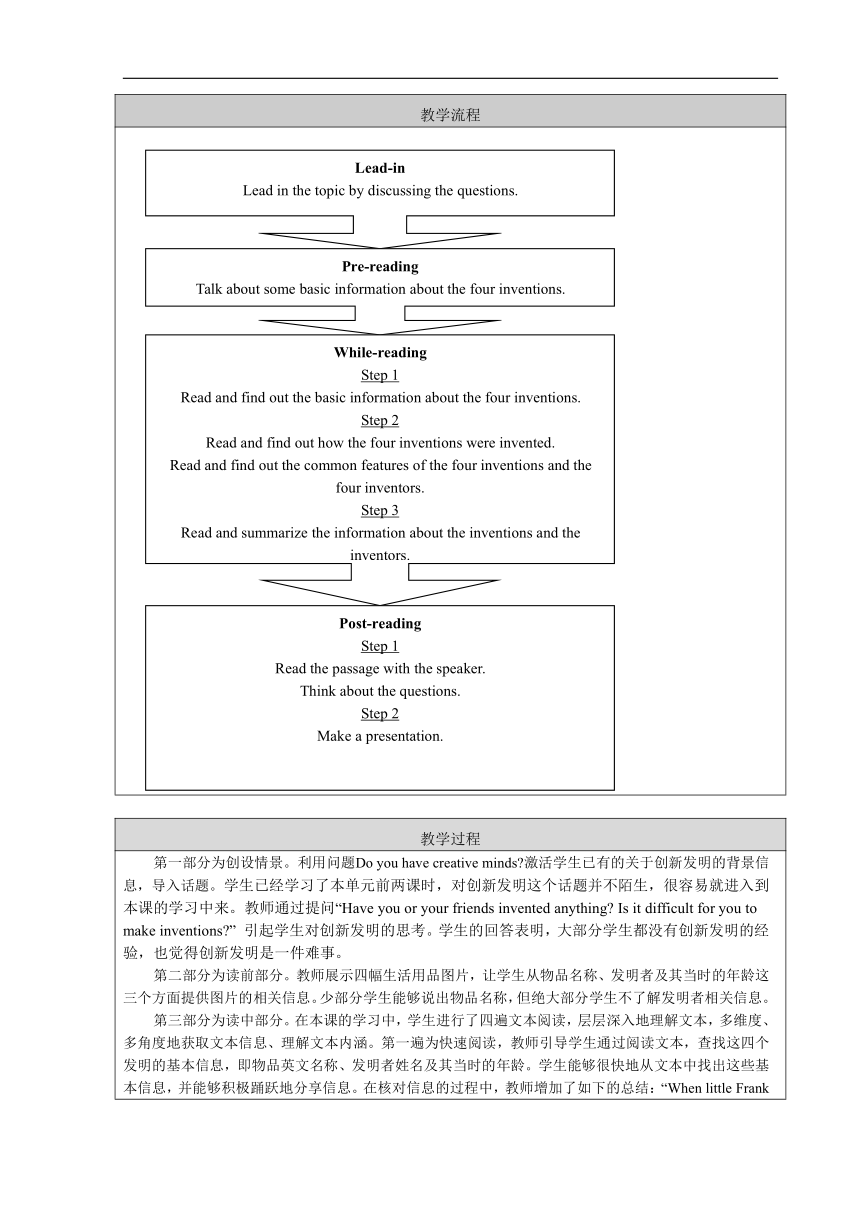Unit 3 Creativity Lesson 9 Creative Minds 教案(表格式)
文档属性
| 名称 | Unit 3 Creativity Lesson 9 Creative Minds 教案(表格式) |  | |
| 格式 | doc | ||
| 文件大小 | 95.6KB | ||
| 资源类型 | 教案 | ||
| 版本资源 | 北师大版 | ||
| 科目 | 英语 | ||
| 更新时间 | 2021-09-29 17:15:15 | ||
图片预览




文档简介
教学基本信息
课题
Lesson
9
Creative
Minds
是否属于
地方课程或校本课程
否
学科
英语
学段:
初中
年级
初中三年级
相关
领域
发明与技术(Inventions
and
technological
advances)
教材
书名:《英语》
出版社:北京师范大学出版社
出版日期:2015年7月
指导思想与理论依据
《义务教育英语课程标准(2011年版)》中提出“英语课程具有工具性和人文性双重性质。就工具性而言,英语课程承担着培养学生基本英语素养和发展学生思维能力的任务,即学生通过英语课程掌握基本的英语语言知识,发展基本的英语听、说、读、写技能,初步形成用英语与他人交流的能力,进一步促进思维能力的发展,为今后继续学习英语和用英语学习其他相关科学文化知识奠定基础。就人文性而言,英语课程承担着提高学生综合人文素养的任务,即学生通过英语课程能够开阔视野,丰富生活经历,形成跨文化意识,增强爱国主义精神,发展创新能力,形成良好的品格和正确的人生观与价值观。”
蒋京丽老师在《对初中英语教师学科教学核心素养的讨论》
一文中指出“英语教师不仅要传授语言知识,训练语言技能,更要认真思考和充分挖掘学习内容对学生的成长具有积极正向影响的因素,启发、引导并帮助学生全方位地体会其中蕴含的哲理,从而促进学生良好品格和综合素养的形成,使初中英语课程的魅力更凝重、更持久。”
本节课的教学设计体现了以上这些指导思想,具体如下:
阅读过程中,教师通过有效的提问和追问指导学生获取文本基本信息,并理解文本深层意义,帮助学生由浅入深地理解文本。这有利于学生发展基本的阅读技能,促进学生思维能力的发展,更有利于学生初步挖掘和学习文本的深层内涵。
在读后环节,教师基于学生已经掌握的文本信息,提问了学生对创新发明的新理解以及作者创作这篇文章的意图,这两个问题使学生将本课所学信息联系到学生自己身上,回归了学生自己的生活。这有利于学生结合自身的生活经验用英语进行批判性思考和表达,发展基本的语言技能,更有利于学生认真思考和充分挖掘学习内容对他们成长具有的积极正向影响,从而引导学生发展创新能力,形成良好的品格和正确的人生观和价值观。
教学背景分析
教学内容:
教学内容为北师大版初中《英语》九年级第三单元第9课,该单元的话题为创造力,属于《课标》话题第22项“科普知识与现代技术(Popular
science
and
modern
technology)”中第78条子话题“发明与技术(Inventions
and
technological
advances)”。第9课Creative
Minds是第三单元的第3课,学生在前两课中阅读了发明家达芬奇的故事,并通过听力学习了一段关于发明的辩论。
本节课是一节阅读课,文章介绍了“冰棒、耳罩、蜡笔套和手腕套”发明的故事。文章由三部分组成:第一部分由文章第一段构成,为引入段,目的是引入话题;第二部分由文章第二、三、四、五段构成,分别讲述了“冰棒、耳罩、蜡笔套和手腕套”发明的故事;第三部分由文章最后一段构成,作者总结了四个发明的共同特点,即它们都是由青少年发明创作的,这一段是文章的总结升华部分,目的是启发学生思考,鼓励学生勇于探索创新。
在阅读技能方面,本课不仅适合培养学生理解事件发生顺序、人物行为的能力,而且也非常适合培养学生理解文章深层含义,理解作者写作意图的能力。
本节课的生词较多,本课出现的生词有:发明物的名称,如Popsicles,Earmuffs,Crayon
holders,Wristies;发明物所使用的材料,如wire,fur,a
steel
headband,tube;以及一些其他的词汇,如treat,cover,fit
tightly。这使得文章适合培养学生根据上下文理解生词含义的能力,例如学生可以根据上下文推测出名词treat和动词cover的意思。
通过逐步地深层挖掘文本信息,学生对创新发明形成了新的思考和理解,即创新发明并不是一件难事,只要青少年对日常生活中遇到的问题乐于探究、善于改进,就有可能进行发明创新。这有利于帮助丰富学生的生活经验,促进其良好品格的形成。
学生情况:
本节课的授课对象为北京市第二中学分校初三年级的学生。在语言知识层面,学生能够认读本课除生词外的大部分词汇,基本具备用英语正确表达意思的能力,但对于文章中出现的有关“冰棒、耳罩、蜡笔套和手腕套”的英语词汇了解不多,因此这些词汇需要课上学习。在阅读技能方面,学生已经可以通过阅读文段获取文章基本信息,也基本具备从上下文中推断生词的能力,但深层次挖掘和概括分析人物、事物特点和理解作者写作意图的能力尚有不足,因此这一部分成为本课课堂教学的重点,需要教师在课堂上层层递进地引导学生深入思考文章。在话题方面,创新是学生学习中的一个热点话题,青少年具有活跃的思维、敏锐的洞察力和丰富的想象力,而人们却很少鼓励青少年关注生活中的问题,并鼓励青少年运用他们的智慧去探索和创新,因此教师要在课堂上引导并帮助学生形成对创新发明的新的理解和认识,即鼓励学生关注生活中的小问题,并运用他们的智慧去探索和创新。
教学方式:
1.层层递进的阅读任务帮助学生顺利、高效地完成学习过程。
本节阅读课的设计,遵循了语言学习的认知规律,即信息获取输入、信息理解内化、结合自身经验地信息输出。教师针对每一个环节的教学意图设计了明确有效的教学活动,前一个教学活动为后一个教学活动的基础,由浅入深地、逐步地引导学生理解文本的深层含义。
深层理解文章信息为本节课的教学难点。因此,在学生理解深层含义之前,学生先是获取了文本的基本信息,之后又通过提问逐段理解段落的深层含义。在完成了这两部分之后,再整合全文理解全文的深层含义以及作者的写作意图就变得简单了。
2.有效的提问和追问帮助学生获取主线信息、理解深层内涵。
课堂设问、追问是英语教学的重要组成部分,通过教师的设问、追问推进了文本阅读理解和思考的进程。通过教师在读前提问“Is
it
difficult
for
you
to
make
inventions ”
引起学生思考,在学完整篇课文后再次追问此问题“Is
it
difficult
for
you
to
make
inventions ”,启发学生向文章介绍的四位青少年发明家学习,启发学生意识到发明创作不是一件难事,并鼓励学生在生活中勇于创新探索。读中部分,在引导学生阅读完文本后,教师又对每一个小故事进行了有效地追问,例如:How
did
he
use
his
creative
minds
to
solve
the
problem
Is
it
difficult
to
find
these
materials
at
home
Is
it
a
big
problem
or
a
small
problem
等,这些问题有效地帮助了学生对文本进行深入地思考,从而帮助学生形成勇于创新的意识。学生的思考能力得到了发展,思维进一步深化。
3.多形式的词汇教学帮助学生有效理解词义、培养词汇学习策略。
词汇教学也是本课的一项重要内容,针对不同的词汇教师选用了不同的词汇教学方式。对于生词treat和cover,教师引导学生通过上下文猜测出词意,让学生掌握通过上下文来猜词的技巧。对那些不能直接通过上下文推测意思的生词,如wire,fur,a
steel
headband,tube等,教师通过真实物品展示让学生直接建立生词与实物之间的联系,建立英语思维习惯。这些都有助于学生词汇学习策略的培养。
教学手段:教材、学案、板书以及PPT
技术准备:电脑,多媒体,实物教具
教学目标
在本节课结束时,学生能够:
1.通过阅读,获取有关“冰棒、耳套、蜡笔套和手腕套”四个发明的信息,以及发明创作的原因、经过和结果。
2.通过阅读,总结这四项发明和这四位青少年发明家的共同特点,并讨论作为青少年的学生是否能进行发明创造。
3.运用阅读中获取的信息,简述文章中一项发明创造的故事,并谈论少年发明家具有的创造性思维。
4.对日常生活中遇到的问题乐于探究、善于改进,有意识地运用他们的智慧去探索和创新。
教学重点和难点:
教学重点为引导学生获取文本的基本信息和深层信息,以及引导学生对创新发明形成新的理解和认识。教学难点为引导学生挖掘文本深层信息。
教学难点解决方式:
教学活动层层递进,由表及里一步一步地引导学生挖掘文本深层信息,具体操作如下:先通过对主线信息的设问指导学生理解文本基本信息,再通过追问引导学生分段理解文本深层信息,最后通过讨论指导学生总结概括整篇文章的写作意图。
教学流程
(
Lead-in
Lead
in
the
topic
by
discussing
the
questions.
Pre-reading
Talk
about
some
basic
information
about
the
four
inventions
.
While-reading
Step
1
Read
and
find
out
the
basic
information
about
the
four
inventions.
Step
2
Read
and
find
out
how
the
four
inventions
were
invented.
Read
and
find
out
the
common
features
of
the
four
inventions
and
the
four
inventors
.
Step
3
Read
and
summarize
the
information
about
the
inventions
and
the
inventors
.
Post-reading
Step
1
Read
the
passage
with
the
speaker.
Think
about
the
questions.
Step
2
Make
a
presentation
.
)
教学过程
第一部分为创设情景。利用问题Do
you
have
creative
minds 激活学生已有的关于创新发明的背景信息,导入话题。学生已经学习了本单元前两课时,对创新发明这个话题并不陌生,很容易就进入到本课的学习中来。教师通过提问“Have
you
or
your
friends
invented
anything
Is
it
difficult
for
you
to
make
inventions ”
引起学生对创新发明的思考。学生的回答表明,大部分学生都没有创新发明的经验,也觉得创新发明是一件难事。
第二部分为读前部分。教师展示四幅生活用品图片,让学生从物品名称、发明者及其当时的年龄这三个方面提供图片的相关信息。少部分学生能够说出物品名称,但绝大部分学生不了解发明者相关信息。
第三部分为读中部分。在本课的学习中,学生进行了四遍文本阅读,层层深入地理解文本,多维度、多角度地获取文本信息、理解文本内涵。第一遍为快速阅读,教师引导学生通过阅读文本,查找这四个发明的基本信息,即物品英文名称、发明者姓名及其当时的年龄。学生能够很快地从文本中找出这些基本信息,并能够积极踊跃地分享信息。在核对信息的过程中,教师增加了如下的总结:“When
little
Frank
made
this
invention,
he
was
only
a
kid.”
“Another
kid
made
the
invention.
”等,这些引导学生关注发明者都是青少年这一事实。
第二遍阅读完成了表层文字理解,教师引导学生通过阅读文本,整理出四个发明来龙去脉的文字信息。学生能够认真阅读文本,在学案上写出四个发明的具体信息,并能够积极踊跃地分享信息。这一教学活动,学生完成的很顺利。在核对信息的过程中,教师引导学生通过上下文猜测生词treat,cover的意思,学生能用英语说出treat的含义,用动作展示cover的意思。对于无法从上下文推测词义的生词,如wire,fur,a
steel
headband,tube等,教师展示了真实物品,学生能够把实物铁丝、皮毛、金属发带和细管子与相应的英文wire、fur、a
steel
headband和tube联系起来,并能够跟随老师朗读这些生词。
在带领学生分享信息过程中和过程后,教师增加了一系列的追问,引导学生进行第三遍阅读,这一遍为快速阅读。对于Popsicles这个发明,教师进行了如下提问:“Is
it
a
big
problem
or
a
small
problem
Have
you
met
such
kind
of
problem
before
in
your
life What
would
happen
if
little
Frank
threw
the
ice
sticks
away
Was
it
easy
for
little
Frank
to
invent
Popsicles
Why
do
you
think
so
”
对于Earmuffs这个发明,教师进行了如下提问:“Is
it
a
big
problem
or
a
small
problem
Are
these
materials
common
in
your
life
Have
you
ever
tried
to
put
them
together
Why
do
you
think
Chester
could
invent
the
first
Earmuffs ”
对于Crayon
holders这个发明,教师进行了如下提问:“Is
it
a
big
problem
or
a
small
problem
Have
you
ever
met
the
same
problem
before
What
did
you
do
Was
it
easy
for
Cassidy
to
solve
the
problem
Why
do
you
think
so ”
对于Wristies这个发明,教师进行了如下提问:“What
is
the
difference
between
mittens
and
Wristies
Why
did
Kathryn
have
the
chance
to
invent
Wristies
but
not
the
other
kids ”
这些问题有效地引导学生对文本信息的深入理解。学生快速阅读文章并思考,积极踊跃地回答了这些问题。对于Popsicles这个发明,学生回答:“Little
Frank
invented
Popsicles
by
accident.”
对于Earmuffs这个发明,学生回答:
“He
is
creative.”
对于Crayon
holders这个发明,学生回答“She
got
a
chance.
She
put
the
plastic
tube
and
the
small
crayons
together.”
学生的回答证明他们已经初步分段理解了文章的深层信息。
第四遍阅读为深入阅读,挖掘整篇文本深层信息。教师引导学生通过再次阅读整篇文本,思考并归纳出发明物和发明家的共同之处,回答“What
do
these
inventions
have
in
common
What
do
these
inventors
have
in
common ”这两个问题,并分享他们的想法和理解。因为之前的教学过程已经为学生铺垫了很多,他们很容易就对这两个问题形成了自己的认识。对于发明物的共同之处,学生一回答:“They
are
very
useful
in
our
life.
Before
the
invention
was
found,
there
was
an
accident
or
chance
for
the
inventor
to
make
the
invention.
”
学生二回答“They
were
all
invented
by
kids.
”
学生三回答“
They
are
all
small
things.
The
kids
were
trying
to
solve
problems
in
our
life.”
对于发明者的共同之处,学生一回答:“They
can
notice
the
small
problem
and
they
can
catch
them.
”
学生二回答“They
are
good
at
using
small
things
in
our
life
and
they
are
all
creative.
”
学生三回答“They
are
all
kids
and
teenagers.
”
这表明学生已经理解了文本的深层涵义。
第四部分为读后部分。教师指导学生朗读课文,重新思考本课导入部分的问题
“Is
it
difficult
for
you
to
make
inventions ”,引导学生思考作者的写作意图,并分享他们的理解。学生跟随录音朗读课文,思考问题“Is
it
easy
for
you
to
make
inventions
Why
Why
did
the
writer
write
this
passage ”。对于创造发明是否很难,学生一回答:“I
think
it
depends.
Nowadays
we
have
all
the
things
we
need
in
our
lives.
So
we
hardly
meet
any
difficulties.
If
we
can’t
meet
the
difficulty,
we
can’t
have
the
idea
of
what
we
have
to
invent
and
what
we
need
to
do.
But
if
we
meet
difficulties,
need
something
and
it
hasn’t
been
invented,
it
becomes
easy
for
us
to
invent
things
to
solve
the
problem.
”
学生二回答“I
think
it
is
not
easy,
because
sometimes
we
meet
a
problem
and
we
get
used
to
it
or
just
ignore
it.”
学生三回答“It
can
be
very
easy.
I
need
to
have
creative
minds.
I
need
to
be
good
at
finding
problems
and
solving
problems.
But
not
just
leave
the
problem
there.
Although
the
problem
may
be
not
just
a
big
deal
like
Li
Jiayi
said,
we
may
just
ignore
it.”
对于作者写作意图,学生回答:“I
think
maybe
the
writer
wants
to
tell
us
that
our
life
is
not
just
that
simple.
Every
day
we
have
dinner
and
study
and
go
to
bed.
We
should
see
our
life
and
maybe
notice
the
small
things
not
just
ignore
them.”
学生的发言展示本课的学习改变了他们对创新发明的畏难态度,认为只要对日常生活中遇到的问题乐于探究、善于改进,就有可能进行发明创新。
学生课后完成作业部分,目的是帮助学生落实课上所学。作业要求学生写出他们心目中最酷的发明,它的发明家是谁,如何发明的,为什么发明者能够创造这个发明物。
教学过程(表格描述)
教学阶段
教师活动
学生活动
设置意图
技术应用
时间安排
导
入
1.
Ask
questions
about
the
topic:
(1).
Do
you
have
creative
minds
(2).
Have
you
or
your
friends
invented
anything
with
your
creative
minds
(3).Is
it
easy
for
you
to
make
inventions
Think
and
answer
the
questions.
联系自身生活经验,熟悉话题、激发学习兴趣。
ppt
1min
读
前
1.
Ask
students
to
see
the
pictures
about
the
four
inventions.
2.
Ask
students
what
they
have
known
about
them.
1.Look
at
the
pictures
and
think
about
the
questions.
2.Share
anything
they
have
known
about
the
pictures.
引导学生运用图片,激活可能已经具备的背景知识。
ppt
2mins
读
中
Activity
1:
1.
Ask
students
to
read
the
passage
for
the
first
time
and
find
out
the
basic
information:
the
names
of
the
inventions,
the
inventors’
names
and
inventors’
age.
Read
the
passage
for
the
first
time
and
find
out
the
basic
information
about
the
four
inventions.
第一遍阅读,训练学生速读查找文章基本信息的能力。
ppt
3mins
Activity
2:
1.
Ask
students
to
read
the
passage
for
the
second
time
and
find
out
how
the
inventors
made
the
inventions.
2.
Ask
students
to
share
what
they
have
found
paragraph
by
paragraph.
3.
Ask
students
to
answer
the
questions
which
help
students
have
a
better
understanding
of
the
passage:
(1).
After
students
finish
reading
the
paragraph
about
Popsicles,
ask
students
these
questions:
Was
it
easy
for
Frank
to
invent
Popsicles
Why
do
you
think
so
(2).
After
students
finish
reading
the
paragraph
about
Earmuffs,
ask
students
this
question:
Why
do
you
think
Chester
could
invent
the
first
earmuffs
(3).
After
students
finish
reading
the
paragraph
about
Crayon
holders,
ask
students
these
questions:
Was
it
easy
for
Cassidy
to
solve
the
problem
Why
do
you
think
so
(4).
After
students
finish
reading
the
paragraph
about
Writsties,
ask
students
these
questions:
What
is
the
difference
between
mittens
and
Wristies
Why
did
Kathryn
have
the
chance
to
invent
Wristies
but
not
the
other
kids
1.Read
the
passage
for
the
second
time
and
fill
in
the
blanks.
2.Share
what
they
have
found
paragraph
by
paragraph.
3.Read
the
passage
again.
Think
and
answer
the
questions.
(1).
Read
the
paraphraph
about
Popsicles,
think
and
answer
these
questions:
Was
it
easy
for
Frank
to
invent
Popsicles
Why
do
you
think
so
(2).
Read
the
paraphraph
about
Earmuffs,
think
and
answer
the
question:
Why
do
you
think
Chester
could
invent
the
first
earmuffs
(3).
Read
the
paraphraph
about
Crayon
holders,
think
and
answer
the
questions:
Was
it
easy
for
Cassidy
to
solve
the
problem
Why
do
you
think
so
(4).
Read
the
paraphraph
about
Writsties,
think
and
answer
the
questions:
What
is
the
difference
between
mittens
and
Wristies
Why
did
Kathryn
have
the
chance
to
invent
Wristies
but
not
the
other
kids
第二遍阅读,获取并整理四个发明创造的起因和过程。并通过问题带领学生进行分段阅读,逐段地较为深入地理解文章。为下个教学活动做准备。
ppt
15mins
Activity
3.
1.
Ask
students
to
read
the
passage
for
the
third
time
and
summarize
the
information
about
inventions
and
inventors.
2.
Ask
students
to
discuss
with
the
partners.
Think
and
summarize
the
information
about
inventions
and
inventors.
Discuss
with
their
partners.
第三遍阅读,从全文角度挖掘文章的深层次信息,总结概括出发明物和发明家的共同特点。
ppt
10mins
读
后
Activity
4.
1.
Ask
students
to
read
the
passage
aloud.
2.
Ask
students
to
think
about
the
questions:
(1).
Is
it
easy
for
you
to
make
inventions
(2).
Why
did
the
writer
write
this
passage
Read
the
passage
aloud.
Think
about
the
questions
and
discuss
with
their
partners.
朗读课文,内化信息。
联系实际生活,批判性地表达对发明创造的认识并理解文章写作目的。
computer
5mins
Activity
5.
1.
Ask
students
to
make
a
presentation:
The
coolest
invention
by
kids.
2.
Ask
one
or
two
students
to
give
a
presentation.
Prepare
the
presentation
with
their
partners.
Give
a
presentation.
复述文章并阐述在学生心目中最酷的由青少年创造的发明。
ppt
Assign
the
homework:
write
down
the
presentation.
强化课上所学。
ppt
学习效果评价设计
评价方式
从四个方面对学生口头输出进行评价:是否介绍了发明家,是否介绍了如何进行的发明,是否介绍了自己的观点,是否喜欢整个演讲过程。
ChecklistI
have
introduced
the
inventor.I
have
introduced
how
the
invention
was
invented.I
have
expressed
my
opinions
about
the
inventor.
I
enjoy
my
presentation.
板书设计
Lesson
9
Creative
Minds
Inventions:
Inventors:
ice--ate---Popsicles
useful
notice
the
small
problem
and
catch
them
cold--made—Earmuffs
possible
chance
be
good
at
using
small
things
small,broken--put--Crayon
holders
by
kids
be
creative
wet--did---Wristies
with
small
things
kids
本教学设计与以往或其他教学设计相比的特点
英语阅读教学是初中英语教学中重要的一部分,学生已经掌握了获取文章表层信息的技能,但学生对文章深层信息的理解能力还较欠缺,这需要教师培养学生认真阅读文章、挖掘文章深层信息的意识和技能。本节课就是这一方面的一个初步探索。
本课话题贴近学生实际生活。教师发现学生觉得创新发明是很难的事情。预测到学生的困惑,教师选取了本篇文章。教师希望通过本课的学习,帮助学生对创新发明形成新的认识和思考,鼓励学生在生活中勇于创新探索。
教师注重对学生语言思维能力和学科核心素养的培养。本节课教师一直在引导学生用英语阅读文本、概括文本信息、理解文本深层内涵、表达自己的观点。同时,教师通过提问引导了学生对创新发明形成新的认识和理解。这体现了英语课程的工具性和人文性,有利于学生发展语言运用能力和思维能力,从而全面提高学生的综合人文素养。
采用了有效的互动阅读教学模式。教师运用设问—引导—启发—对话—交流的模式进行阅读教学,促进了课堂上生生、师生间的交流。问题的设置由浅入深,由易到难,帮助学循序渐进的理解文章深层信息,使学生能够感知文字背后作者灵动的思想和观点,文本在学生积极思考的过程中逐渐鲜活起来。
采用了多种讲解生词的方式。对不同的词汇,教师选用了不同的讲授方法。教师不仅引导学生通过上下文猜测词义理解生词,同时也利用实物教授生词,帮助学生有效地学习了词汇。
课题
Lesson
9
Creative
Minds
是否属于
地方课程或校本课程
否
学科
英语
学段:
初中
年级
初中三年级
相关
领域
发明与技术(Inventions
and
technological
advances)
教材
书名:《英语》
出版社:北京师范大学出版社
出版日期:2015年7月
指导思想与理论依据
《义务教育英语课程标准(2011年版)》中提出“英语课程具有工具性和人文性双重性质。就工具性而言,英语课程承担着培养学生基本英语素养和发展学生思维能力的任务,即学生通过英语课程掌握基本的英语语言知识,发展基本的英语听、说、读、写技能,初步形成用英语与他人交流的能力,进一步促进思维能力的发展,为今后继续学习英语和用英语学习其他相关科学文化知识奠定基础。就人文性而言,英语课程承担着提高学生综合人文素养的任务,即学生通过英语课程能够开阔视野,丰富生活经历,形成跨文化意识,增强爱国主义精神,发展创新能力,形成良好的品格和正确的人生观与价值观。”
蒋京丽老师在《对初中英语教师学科教学核心素养的讨论》
一文中指出“英语教师不仅要传授语言知识,训练语言技能,更要认真思考和充分挖掘学习内容对学生的成长具有积极正向影响的因素,启发、引导并帮助学生全方位地体会其中蕴含的哲理,从而促进学生良好品格和综合素养的形成,使初中英语课程的魅力更凝重、更持久。”
本节课的教学设计体现了以上这些指导思想,具体如下:
阅读过程中,教师通过有效的提问和追问指导学生获取文本基本信息,并理解文本深层意义,帮助学生由浅入深地理解文本。这有利于学生发展基本的阅读技能,促进学生思维能力的发展,更有利于学生初步挖掘和学习文本的深层内涵。
在读后环节,教师基于学生已经掌握的文本信息,提问了学生对创新发明的新理解以及作者创作这篇文章的意图,这两个问题使学生将本课所学信息联系到学生自己身上,回归了学生自己的生活。这有利于学生结合自身的生活经验用英语进行批判性思考和表达,发展基本的语言技能,更有利于学生认真思考和充分挖掘学习内容对他们成长具有的积极正向影响,从而引导学生发展创新能力,形成良好的品格和正确的人生观和价值观。
教学背景分析
教学内容:
教学内容为北师大版初中《英语》九年级第三单元第9课,该单元的话题为创造力,属于《课标》话题第22项“科普知识与现代技术(Popular
science
and
modern
technology)”中第78条子话题“发明与技术(Inventions
and
technological
advances)”。第9课Creative
Minds是第三单元的第3课,学生在前两课中阅读了发明家达芬奇的故事,并通过听力学习了一段关于发明的辩论。
本节课是一节阅读课,文章介绍了“冰棒、耳罩、蜡笔套和手腕套”发明的故事。文章由三部分组成:第一部分由文章第一段构成,为引入段,目的是引入话题;第二部分由文章第二、三、四、五段构成,分别讲述了“冰棒、耳罩、蜡笔套和手腕套”发明的故事;第三部分由文章最后一段构成,作者总结了四个发明的共同特点,即它们都是由青少年发明创作的,这一段是文章的总结升华部分,目的是启发学生思考,鼓励学生勇于探索创新。
在阅读技能方面,本课不仅适合培养学生理解事件发生顺序、人物行为的能力,而且也非常适合培养学生理解文章深层含义,理解作者写作意图的能力。
本节课的生词较多,本课出现的生词有:发明物的名称,如Popsicles,Earmuffs,Crayon
holders,Wristies;发明物所使用的材料,如wire,fur,a
steel
headband,tube;以及一些其他的词汇,如treat,cover,fit
tightly。这使得文章适合培养学生根据上下文理解生词含义的能力,例如学生可以根据上下文推测出名词treat和动词cover的意思。
通过逐步地深层挖掘文本信息,学生对创新发明形成了新的思考和理解,即创新发明并不是一件难事,只要青少年对日常生活中遇到的问题乐于探究、善于改进,就有可能进行发明创新。这有利于帮助丰富学生的生活经验,促进其良好品格的形成。
学生情况:
本节课的授课对象为北京市第二中学分校初三年级的学生。在语言知识层面,学生能够认读本课除生词外的大部分词汇,基本具备用英语正确表达意思的能力,但对于文章中出现的有关“冰棒、耳罩、蜡笔套和手腕套”的英语词汇了解不多,因此这些词汇需要课上学习。在阅读技能方面,学生已经可以通过阅读文段获取文章基本信息,也基本具备从上下文中推断生词的能力,但深层次挖掘和概括分析人物、事物特点和理解作者写作意图的能力尚有不足,因此这一部分成为本课课堂教学的重点,需要教师在课堂上层层递进地引导学生深入思考文章。在话题方面,创新是学生学习中的一个热点话题,青少年具有活跃的思维、敏锐的洞察力和丰富的想象力,而人们却很少鼓励青少年关注生活中的问题,并鼓励青少年运用他们的智慧去探索和创新,因此教师要在课堂上引导并帮助学生形成对创新发明的新的理解和认识,即鼓励学生关注生活中的小问题,并运用他们的智慧去探索和创新。
教学方式:
1.层层递进的阅读任务帮助学生顺利、高效地完成学习过程。
本节阅读课的设计,遵循了语言学习的认知规律,即信息获取输入、信息理解内化、结合自身经验地信息输出。教师针对每一个环节的教学意图设计了明确有效的教学活动,前一个教学活动为后一个教学活动的基础,由浅入深地、逐步地引导学生理解文本的深层含义。
深层理解文章信息为本节课的教学难点。因此,在学生理解深层含义之前,学生先是获取了文本的基本信息,之后又通过提问逐段理解段落的深层含义。在完成了这两部分之后,再整合全文理解全文的深层含义以及作者的写作意图就变得简单了。
2.有效的提问和追问帮助学生获取主线信息、理解深层内涵。
课堂设问、追问是英语教学的重要组成部分,通过教师的设问、追问推进了文本阅读理解和思考的进程。通过教师在读前提问“Is
it
difficult
for
you
to
make
inventions ”
引起学生思考,在学完整篇课文后再次追问此问题“Is
it
difficult
for
you
to
make
inventions ”,启发学生向文章介绍的四位青少年发明家学习,启发学生意识到发明创作不是一件难事,并鼓励学生在生活中勇于创新探索。读中部分,在引导学生阅读完文本后,教师又对每一个小故事进行了有效地追问,例如:How
did
he
use
his
creative
minds
to
solve
the
problem
Is
it
difficult
to
find
these
materials
at
home
Is
it
a
big
problem
or
a
small
problem
等,这些问题有效地帮助了学生对文本进行深入地思考,从而帮助学生形成勇于创新的意识。学生的思考能力得到了发展,思维进一步深化。
3.多形式的词汇教学帮助学生有效理解词义、培养词汇学习策略。
词汇教学也是本课的一项重要内容,针对不同的词汇教师选用了不同的词汇教学方式。对于生词treat和cover,教师引导学生通过上下文猜测出词意,让学生掌握通过上下文来猜词的技巧。对那些不能直接通过上下文推测意思的生词,如wire,fur,a
steel
headband,tube等,教师通过真实物品展示让学生直接建立生词与实物之间的联系,建立英语思维习惯。这些都有助于学生词汇学习策略的培养。
教学手段:教材、学案、板书以及PPT
技术准备:电脑,多媒体,实物教具
教学目标
在本节课结束时,学生能够:
1.通过阅读,获取有关“冰棒、耳套、蜡笔套和手腕套”四个发明的信息,以及发明创作的原因、经过和结果。
2.通过阅读,总结这四项发明和这四位青少年发明家的共同特点,并讨论作为青少年的学生是否能进行发明创造。
3.运用阅读中获取的信息,简述文章中一项发明创造的故事,并谈论少年发明家具有的创造性思维。
4.对日常生活中遇到的问题乐于探究、善于改进,有意识地运用他们的智慧去探索和创新。
教学重点和难点:
教学重点为引导学生获取文本的基本信息和深层信息,以及引导学生对创新发明形成新的理解和认识。教学难点为引导学生挖掘文本深层信息。
教学难点解决方式:
教学活动层层递进,由表及里一步一步地引导学生挖掘文本深层信息,具体操作如下:先通过对主线信息的设问指导学生理解文本基本信息,再通过追问引导学生分段理解文本深层信息,最后通过讨论指导学生总结概括整篇文章的写作意图。
教学流程
(
Lead-in
Lead
in
the
topic
by
discussing
the
questions.
Pre-reading
Talk
about
some
basic
information
about
the
four
inventions
.
While-reading
Step
1
Read
and
find
out
the
basic
information
about
the
four
inventions.
Step
2
Read
and
find
out
how
the
four
inventions
were
invented.
Read
and
find
out
the
common
features
of
the
four
inventions
and
the
four
inventors
.
Step
3
Read
and
summarize
the
information
about
the
inventions
and
the
inventors
.
Post-reading
Step
1
Read
the
passage
with
the
speaker.
Think
about
the
questions.
Step
2
Make
a
presentation
.
)
教学过程
第一部分为创设情景。利用问题Do
you
have
creative
minds 激活学生已有的关于创新发明的背景信息,导入话题。学生已经学习了本单元前两课时,对创新发明这个话题并不陌生,很容易就进入到本课的学习中来。教师通过提问“Have
you
or
your
friends
invented
anything
Is
it
difficult
for
you
to
make
inventions ”
引起学生对创新发明的思考。学生的回答表明,大部分学生都没有创新发明的经验,也觉得创新发明是一件难事。
第二部分为读前部分。教师展示四幅生活用品图片,让学生从物品名称、发明者及其当时的年龄这三个方面提供图片的相关信息。少部分学生能够说出物品名称,但绝大部分学生不了解发明者相关信息。
第三部分为读中部分。在本课的学习中,学生进行了四遍文本阅读,层层深入地理解文本,多维度、多角度地获取文本信息、理解文本内涵。第一遍为快速阅读,教师引导学生通过阅读文本,查找这四个发明的基本信息,即物品英文名称、发明者姓名及其当时的年龄。学生能够很快地从文本中找出这些基本信息,并能够积极踊跃地分享信息。在核对信息的过程中,教师增加了如下的总结:“When
little
Frank
made
this
invention,
he
was
only
a
kid.”
“Another
kid
made
the
invention.
”等,这些引导学生关注发明者都是青少年这一事实。
第二遍阅读完成了表层文字理解,教师引导学生通过阅读文本,整理出四个发明来龙去脉的文字信息。学生能够认真阅读文本,在学案上写出四个发明的具体信息,并能够积极踊跃地分享信息。这一教学活动,学生完成的很顺利。在核对信息的过程中,教师引导学生通过上下文猜测生词treat,cover的意思,学生能用英语说出treat的含义,用动作展示cover的意思。对于无法从上下文推测词义的生词,如wire,fur,a
steel
headband,tube等,教师展示了真实物品,学生能够把实物铁丝、皮毛、金属发带和细管子与相应的英文wire、fur、a
steel
headband和tube联系起来,并能够跟随老师朗读这些生词。
在带领学生分享信息过程中和过程后,教师增加了一系列的追问,引导学生进行第三遍阅读,这一遍为快速阅读。对于Popsicles这个发明,教师进行了如下提问:“Is
it
a
big
problem
or
a
small
problem
Have
you
met
such
kind
of
problem
before
in
your
life What
would
happen
if
little
Frank
threw
the
ice
sticks
away
Was
it
easy
for
little
Frank
to
invent
Popsicles
Why
do
you
think
so
”
对于Earmuffs这个发明,教师进行了如下提问:“Is
it
a
big
problem
or
a
small
problem
Are
these
materials
common
in
your
life
Have
you
ever
tried
to
put
them
together
Why
do
you
think
Chester
could
invent
the
first
Earmuffs ”
对于Crayon
holders这个发明,教师进行了如下提问:“Is
it
a
big
problem
or
a
small
problem
Have
you
ever
met
the
same
problem
before
What
did
you
do
Was
it
easy
for
Cassidy
to
solve
the
problem
Why
do
you
think
so ”
对于Wristies这个发明,教师进行了如下提问:“What
is
the
difference
between
mittens
and
Wristies
Why
did
Kathryn
have
the
chance
to
invent
Wristies
but
not
the
other
kids ”
这些问题有效地引导学生对文本信息的深入理解。学生快速阅读文章并思考,积极踊跃地回答了这些问题。对于Popsicles这个发明,学生回答:“Little
Frank
invented
Popsicles
by
accident.”
对于Earmuffs这个发明,学生回答:
“He
is
creative.”
对于Crayon
holders这个发明,学生回答“She
got
a
chance.
She
put
the
plastic
tube
and
the
small
crayons
together.”
学生的回答证明他们已经初步分段理解了文章的深层信息。
第四遍阅读为深入阅读,挖掘整篇文本深层信息。教师引导学生通过再次阅读整篇文本,思考并归纳出发明物和发明家的共同之处,回答“What
do
these
inventions
have
in
common
What
do
these
inventors
have
in
common ”这两个问题,并分享他们的想法和理解。因为之前的教学过程已经为学生铺垫了很多,他们很容易就对这两个问题形成了自己的认识。对于发明物的共同之处,学生一回答:“They
are
very
useful
in
our
life.
Before
the
invention
was
found,
there
was
an
accident
or
chance
for
the
inventor
to
make
the
invention.
”
学生二回答“They
were
all
invented
by
kids.
”
学生三回答“
They
are
all
small
things.
The
kids
were
trying
to
solve
problems
in
our
life.”
对于发明者的共同之处,学生一回答:“They
can
notice
the
small
problem
and
they
can
catch
them.
”
学生二回答“They
are
good
at
using
small
things
in
our
life
and
they
are
all
creative.
”
学生三回答“They
are
all
kids
and
teenagers.
”
这表明学生已经理解了文本的深层涵义。
第四部分为读后部分。教师指导学生朗读课文,重新思考本课导入部分的问题
“Is
it
difficult
for
you
to
make
inventions ”,引导学生思考作者的写作意图,并分享他们的理解。学生跟随录音朗读课文,思考问题“Is
it
easy
for
you
to
make
inventions
Why
Why
did
the
writer
write
this
passage ”。对于创造发明是否很难,学生一回答:“I
think
it
depends.
Nowadays
we
have
all
the
things
we
need
in
our
lives.
So
we
hardly
meet
any
difficulties.
If
we
can’t
meet
the
difficulty,
we
can’t
have
the
idea
of
what
we
have
to
invent
and
what
we
need
to
do.
But
if
we
meet
difficulties,
need
something
and
it
hasn’t
been
invented,
it
becomes
easy
for
us
to
invent
things
to
solve
the
problem.
”
学生二回答“I
think
it
is
not
easy,
because
sometimes
we
meet
a
problem
and
we
get
used
to
it
or
just
ignore
it.”
学生三回答“It
can
be
very
easy.
I
need
to
have
creative
minds.
I
need
to
be
good
at
finding
problems
and
solving
problems.
But
not
just
leave
the
problem
there.
Although
the
problem
may
be
not
just
a
big
deal
like
Li
Jiayi
said,
we
may
just
ignore
it.”
对于作者写作意图,学生回答:“I
think
maybe
the
writer
wants
to
tell
us
that
our
life
is
not
just
that
simple.
Every
day
we
have
dinner
and
study
and
go
to
bed.
We
should
see
our
life
and
maybe
notice
the
small
things
not
just
ignore
them.”
学生的发言展示本课的学习改变了他们对创新发明的畏难态度,认为只要对日常生活中遇到的问题乐于探究、善于改进,就有可能进行发明创新。
学生课后完成作业部分,目的是帮助学生落实课上所学。作业要求学生写出他们心目中最酷的发明,它的发明家是谁,如何发明的,为什么发明者能够创造这个发明物。
教学过程(表格描述)
教学阶段
教师活动
学生活动
设置意图
技术应用
时间安排
导
入
1.
Ask
questions
about
the
topic:
(1).
Do
you
have
creative
minds
(2).
Have
you
or
your
friends
invented
anything
with
your
creative
minds
(3).Is
it
easy
for
you
to
make
inventions
Think
and
answer
the
questions.
联系自身生活经验,熟悉话题、激发学习兴趣。
ppt
1min
读
前
1.
Ask
students
to
see
the
pictures
about
the
four
inventions.
2.
Ask
students
what
they
have
known
about
them.
1.Look
at
the
pictures
and
think
about
the
questions.
2.Share
anything
they
have
known
about
the
pictures.
引导学生运用图片,激活可能已经具备的背景知识。
ppt
2mins
读
中
Activity
1:
1.
Ask
students
to
read
the
passage
for
the
first
time
and
find
out
the
basic
information:
the
names
of
the
inventions,
the
inventors’
names
and
inventors’
age.
Read
the
passage
for
the
first
time
and
find
out
the
basic
information
about
the
four
inventions.
第一遍阅读,训练学生速读查找文章基本信息的能力。
ppt
3mins
Activity
2:
1.
Ask
students
to
read
the
passage
for
the
second
time
and
find
out
how
the
inventors
made
the
inventions.
2.
Ask
students
to
share
what
they
have
found
paragraph
by
paragraph.
3.
Ask
students
to
answer
the
questions
which
help
students
have
a
better
understanding
of
the
passage:
(1).
After
students
finish
reading
the
paragraph
about
Popsicles,
ask
students
these
questions:
Was
it
easy
for
Frank
to
invent
Popsicles
Why
do
you
think
so
(2).
After
students
finish
reading
the
paragraph
about
Earmuffs,
ask
students
this
question:
Why
do
you
think
Chester
could
invent
the
first
earmuffs
(3).
After
students
finish
reading
the
paragraph
about
Crayon
holders,
ask
students
these
questions:
Was
it
easy
for
Cassidy
to
solve
the
problem
Why
do
you
think
so
(4).
After
students
finish
reading
the
paragraph
about
Writsties,
ask
students
these
questions:
What
is
the
difference
between
mittens
and
Wristies
Why
did
Kathryn
have
the
chance
to
invent
Wristies
but
not
the
other
kids
1.Read
the
passage
for
the
second
time
and
fill
in
the
blanks.
2.Share
what
they
have
found
paragraph
by
paragraph.
3.Read
the
passage
again.
Think
and
answer
the
questions.
(1).
Read
the
paraphraph
about
Popsicles,
think
and
answer
these
questions:
Was
it
easy
for
Frank
to
invent
Popsicles
Why
do
you
think
so
(2).
Read
the
paraphraph
about
Earmuffs,
think
and
answer
the
question:
Why
do
you
think
Chester
could
invent
the
first
earmuffs
(3).
Read
the
paraphraph
about
Crayon
holders,
think
and
answer
the
questions:
Was
it
easy
for
Cassidy
to
solve
the
problem
Why
do
you
think
so
(4).
Read
the
paraphraph
about
Writsties,
think
and
answer
the
questions:
What
is
the
difference
between
mittens
and
Wristies
Why
did
Kathryn
have
the
chance
to
invent
Wristies
but
not
the
other
kids
第二遍阅读,获取并整理四个发明创造的起因和过程。并通过问题带领学生进行分段阅读,逐段地较为深入地理解文章。为下个教学活动做准备。
ppt
15mins
Activity
3.
1.
Ask
students
to
read
the
passage
for
the
third
time
and
summarize
the
information
about
inventions
and
inventors.
2.
Ask
students
to
discuss
with
the
partners.
Think
and
summarize
the
information
about
inventions
and
inventors.
Discuss
with
their
partners.
第三遍阅读,从全文角度挖掘文章的深层次信息,总结概括出发明物和发明家的共同特点。
ppt
10mins
读
后
Activity
4.
1.
Ask
students
to
read
the
passage
aloud.
2.
Ask
students
to
think
about
the
questions:
(1).
Is
it
easy
for
you
to
make
inventions
(2).
Why
did
the
writer
write
this
passage
Read
the
passage
aloud.
Think
about
the
questions
and
discuss
with
their
partners.
朗读课文,内化信息。
联系实际生活,批判性地表达对发明创造的认识并理解文章写作目的。
computer
5mins
Activity
5.
1.
Ask
students
to
make
a
presentation:
The
coolest
invention
by
kids.
2.
Ask
one
or
two
students
to
give
a
presentation.
Prepare
the
presentation
with
their
partners.
Give
a
presentation.
复述文章并阐述在学生心目中最酷的由青少年创造的发明。
ppt
Assign
the
homework:
write
down
the
presentation.
强化课上所学。
ppt
学习效果评价设计
评价方式
从四个方面对学生口头输出进行评价:是否介绍了发明家,是否介绍了如何进行的发明,是否介绍了自己的观点,是否喜欢整个演讲过程。
ChecklistI
have
introduced
the
inventor.I
have
introduced
how
the
invention
was
invented.I
have
expressed
my
opinions
about
the
inventor.
I
enjoy
my
presentation.
板书设计
Lesson
9
Creative
Minds
Inventions:
Inventors:
ice--ate---Popsicles
useful
notice
the
small
problem
and
catch
them
cold--made—Earmuffs
possible
chance
be
good
at
using
small
things
small,broken--put--Crayon
holders
by
kids
be
creative
wet--did---Wristies
with
small
things
kids
本教学设计与以往或其他教学设计相比的特点
英语阅读教学是初中英语教学中重要的一部分,学生已经掌握了获取文章表层信息的技能,但学生对文章深层信息的理解能力还较欠缺,这需要教师培养学生认真阅读文章、挖掘文章深层信息的意识和技能。本节课就是这一方面的一个初步探索。
本课话题贴近学生实际生活。教师发现学生觉得创新发明是很难的事情。预测到学生的困惑,教师选取了本篇文章。教师希望通过本课的学习,帮助学生对创新发明形成新的认识和思考,鼓励学生在生活中勇于创新探索。
教师注重对学生语言思维能力和学科核心素养的培养。本节课教师一直在引导学生用英语阅读文本、概括文本信息、理解文本深层内涵、表达自己的观点。同时,教师通过提问引导了学生对创新发明形成新的认识和理解。这体现了英语课程的工具性和人文性,有利于学生发展语言运用能力和思维能力,从而全面提高学生的综合人文素养。
采用了有效的互动阅读教学模式。教师运用设问—引导—启发—对话—交流的模式进行阅读教学,促进了课堂上生生、师生间的交流。问题的设置由浅入深,由易到难,帮助学循序渐进的理解文章深层信息,使学生能够感知文字背后作者灵动的思想和观点,文本在学生积极思考的过程中逐渐鲜活起来。
采用了多种讲解生词的方式。对不同的词汇,教师选用了不同的讲授方法。教师不仅引导学生通过上下文猜测词义理解生词,同时也利用实物教授生词,帮助学生有效地学习了词汇。
同课章节目录
- Unit 1 Language
- Lesson 1 Body Language
- Lesson 2 Different Kinds of Language
- Lesson 3 Language Learning Tips
- Communication Workshop
- Unit 2 Books
- Lesson 4 Classics
- Lesson 5 The Book Club
- Lesson 6 Tom Sawye
- Communication Workshop
- Unit 3 Creativity
- Lesson 7 A Famous Invento
- Lesson 8 Good or Bad?
- Lesson 9 Creative Minds
- Communication Workshop
- Unit 4 Space
- Lesson 10 Life in Space
- Lesson 11 The Amazing Shenzhou
- Lesson 12 The Spaceship
- Communication Workshop
- Unit 5 Literature
- Lesson 13 Anne of Green Gables
- Lesson 14 The Dark Room
- Lesson 15 A Famous Write
- Communication Workshop
- Unit 6 Role Models
- Lesson 16 Yao Ming
- Lesson 17 People in Our Lives
- Lesson 18 Steve Jobs
- Communication Workshop
- Unit 7 Journeys
- Lesson 19 The Silk Road
- Lesson 20 Life in a Journey
- Lesson 21 To the South Pole
- Communication Workshop
- Unit 8 Discoveries
- Lesson 22 Famous Discoveries
- Lesson 23 Discovery of the Yea
- Lesson 24 An Experiment Report
- Communication Workshop
- Unit 9 Save the Planet
- Lesson 25 Going Green
- Lesson 26 Our Rive
- Lesson 27 Tree Heroes
- Communication Workshop
